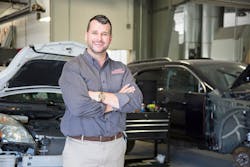SHOP STATS: Auto Collision & Glass Location: Four locations in the New York area Operator: Richard Greenawalt, R.G. Greenawalt, Juanita Greenawalt-Slobe Average Monthly Car Count: 300 (combined for all locations) Staff Size: 60 (combined for all locations) Annual Revenue: $8.5 million (combined for all locations)
With a minor in industrial organizational psychology, R.G. Greenawalt, owner of the five-location Auto Collision & Glass in New York, knows the importance of organization and assigning roles. When he began working full time for his family’s business in 2001, he took what he learned in school and applied it to the business. This included clearly defining roles in the shop, creating customer-centric SOPs and—three years ago—an overhaul of the shop’s blueprinting process.
The shop, with help from Axalta, its paint company, took a hard look at what it was doing during the blueprinting process at the time and made the necessary changes. Before, Auto Collision & Glass had a front-end estimator that would handle a claim from start to finish. With this method, Greenawalt found that things were overlooked and supplements were frequent, which was a problem.
“If you get a week-long job done in three days, it’s not impressive if the customer has to come back,” Greenawalt says. “That just means that everyone has to do the job that should have been done right the first time for a second time.”
As soon as the shop made the switch, CSI scores increased immediately. Since then, the shop has consistently posted a CSI of 96 or higher and recently received the 2016 Excellence in CSI for best claim cycle time from Mike Anderson’s legacy group.
Blueprinting is like faxing a piece of paper. If you stick the paper in straight and type the number in correctly, it’s an easy and efficient process. If you stick the paper in crooked—it jams everything up. We’ve implemented a system in our shop where everyone now has a defined role and major responsibilities, or what I refer to as their MRs. This helps clear things up and make sure nothing is overlooked.
An example of this is our customer service representatives. We have many SOPs in place that are all focused on the customer’s experience. The customer service representatives’ MRs revolve around keeping the customer informed. It’s their job to keep the customer updated in whatever form the customer prefers, whether it be phone call, texting or emails. The CSR also does follow-ups 48 hours after the repair to check in on their experience. They’re the ones that have the most interaction with our customers, so it’s their role to make people feel at home. I have front-end staff and back-end staff and within those designations, everyone knows what is expected of them.
We want to identify all damages from the get-go during blueprinting. If something is not identified, I’ll have a supplement, which basically means we have to do the job twice. If this happens, I won’t hit my estimated completion date (ECD), and from everything I’ve seen, if the ECD isn’t hit, then CSI goes down. Nine times out of 10, a bad customer experience can be traced back to the blueprinting process. There are many KPIs, such as cycle time and length of rental, but the one that concerns me the most is CSI. If a job is finished ahead of schedule but it’s not done correctly, it doesn’t matter.
Auto Collision & Glass has five dedicated repair planners. The repair planners are focused on blueprinting and their MRs all have to do with that process. I evaluate them on those MRs and will check in and let them know if something isn’t working or they can come to me with an issue. We’re always revisiting the process and looking for ways to improve.
The first thing that we do for blueprinting is we walk around a vehicle with the customer and identify the damage with a marker. Then, we do a pre-wash of the vehicle and pull the vehicle into the blueprinting department. The damage is then identified and documented and then the vehicle is dismantled.
If someone is having trouble with blueprinting, I recommend setting up a process right off the bat and getting the entire team involved. The repair planner writes the plan, the detailer is in charge of washing the vehicle, the parts manager orders parts, the body man gets hands-on and disassembles the car. We even have the painter come over and look at the repair plan to make sure that everything in their area has been accounted for. It’s better to do it now when everyone has time rather than coming back to do something later when someone might be busy.
We identify and touch all of the parts to check for damage. I think that’s a big area for shops to improve. Once everything has been identified, a technician signs off on the estimate. That’s not to say we can’t go back and add something, that’s just so we can have a second set of eyes looking at it. The blueprinting process, especially with larger hits, is often sped through. Slow down. Do a 100 percent disassembly. Touch everything. Touch the clips and the retainers, those are easy parts to miss.
For many shops, parts are an Achilles’ heel. Delays are usually caused due to parts issues. We’ve implemented a parts procurement process and it’s decluttered the shop and kept us more organized. Any parts that are being replaced are put on a parts cart and any part that we’ll still be using goes into a bin. Do not keep parts inside a car. Put them in a secure area where they’ll be accounted for. The parts that are being replaced go onto carts because they’ll be touched multiple times, so they’re easier to access. When parts come in, our parts manager mirror matches everything. We want to do this right away when the parts come in. It’s better to check this on the second day of the vehicle repair versus the fourth.
It’s amazing what you can learn from your peers. When I first started blueprinting, we started reaching out to our peers and got involved with a 20 Group. I thought I knew a lot then but now I feel like I know less than I did three years ago. There’s so much I still have to learn, there are so many different levels.
Having clearly defined roles helps. It has created checks and balances. For example, my father is still involved in the business, as is my sister. We each have different things that we are responsible for. When you stay in your own lane, everything is fine—it’s when you switch lanes that accidents happen.
A Day in the Life
—
A typical day in the life of a successful MSO owner starts early … very early. Here’s what a typical day for R.G. Greenawalt looks like:
5:15 Wake up
5:45-6:30 Work out
7:15 Breakfast
7:45-8:00 Coordinate and follow-up with team members on the phone during drive to the shop.
8:00 Arrive at office.
8:00-8:30 Check emails and respond.
8:30-9:30 Check LOR, CSI results, indicator reports and insurance score cards.
9:30-12:00 Stay at one location and assist wherever needed. It could be coaching CSR, blueprinting, quality control or sweeping floors.
12:00-12:30 Lunch break
12:30-4:00 Visit a second location and help out wherever is needed.
4:00-5:00 Phone calls and meetings
5:00 Head home



